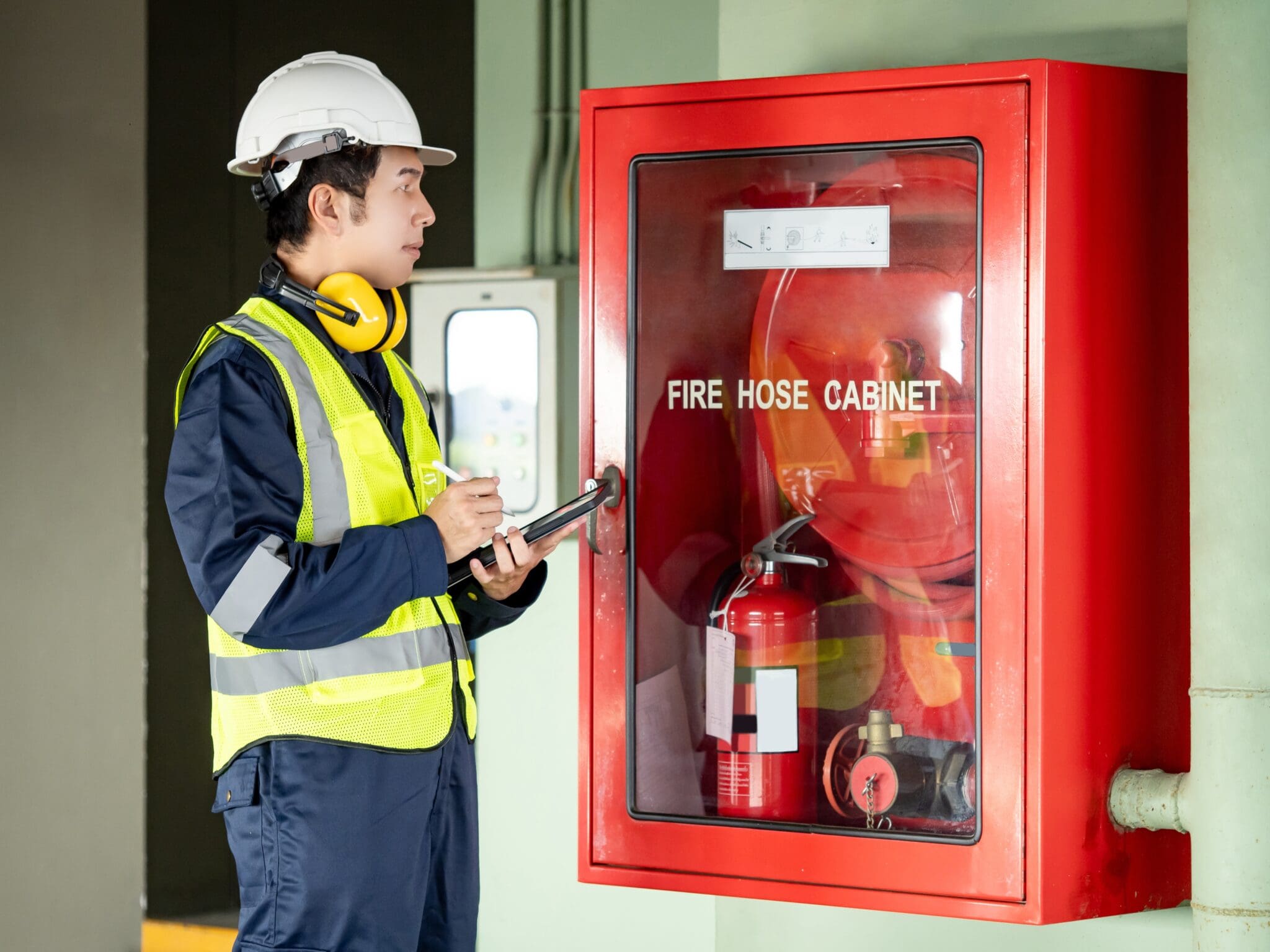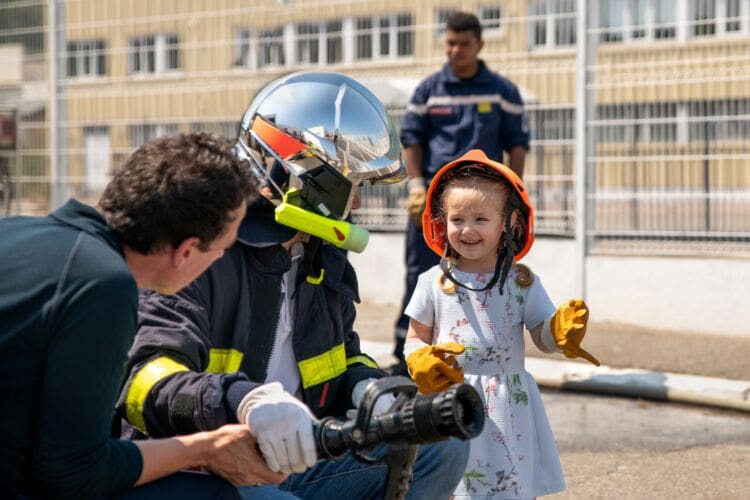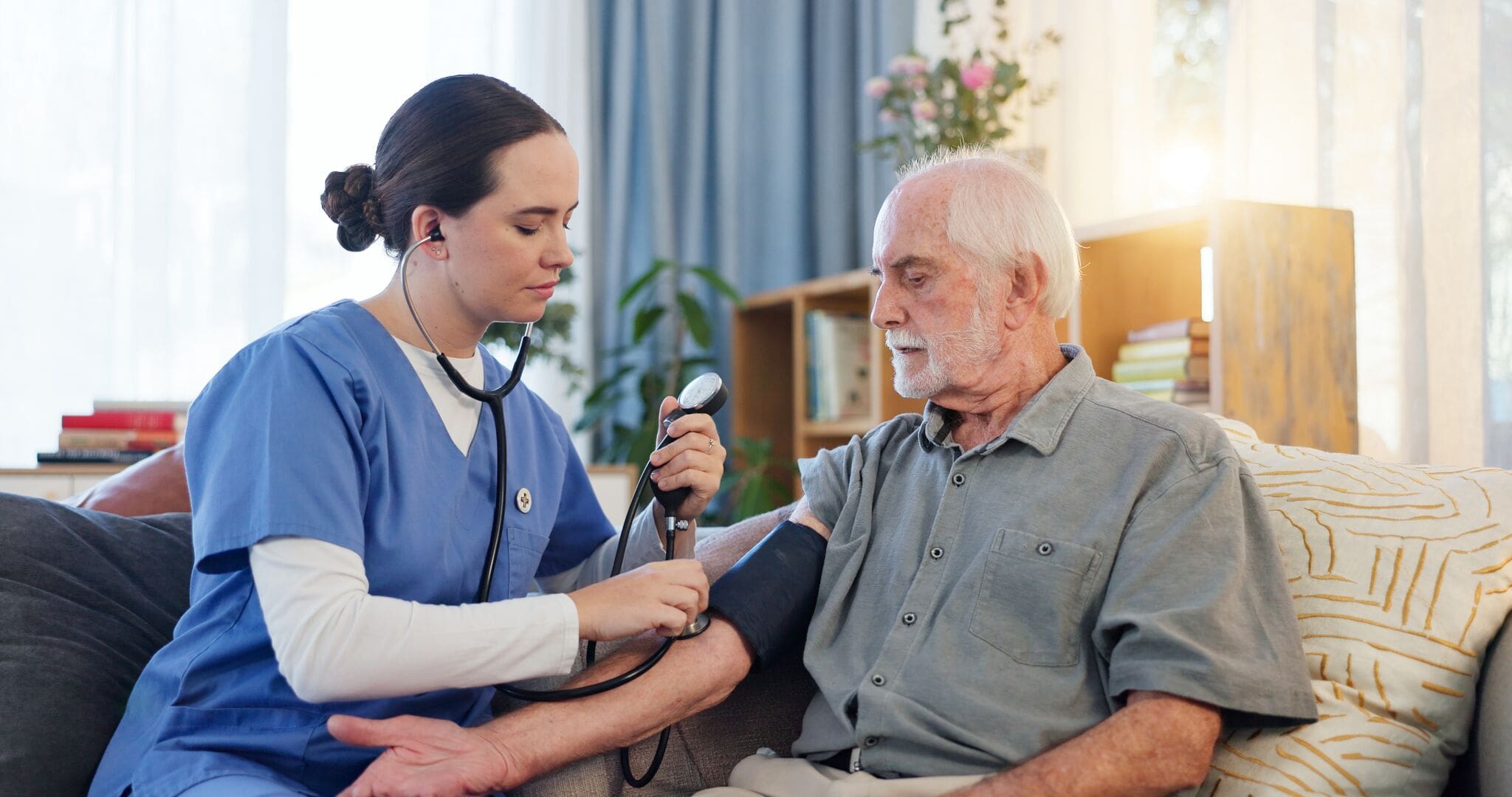In this article
Fireproofing in schools is about reducing fire risks and protecting lives, buildings, and equipment. Schools are responsible for keeping pupils and staff safe, which means following best practices for prevention, containment, and response. This includes materials, building design, systems, inspections, and clear roles in emergencies.
Between April 2015 and April 2020, 1,467 primary schools and 834 secondary schools had an incident where there was a fire, and just two per cent of these schools were fitted with sprinklers, according to a study published by Zurich. In England, schools are not legally required to have sprinklers, but they are strongly recommended in certain cases. The official guidance on fire safety in schools, states that all new school buildings should have sprinklers installed unless a risk assessment shows they are not necessary.
Fire safety risk assessment (FSRA)
An FSRA is a Fire Safety Risk Assessment. It is a structured review of the building, people, and procedures in order to identify fire hazards, assess the risk to people, and determine what needs to be done in order to keep everyone safe. It is a legal requirement under the Regulatory Reform (Fire Safety) Order 2005. Every school must have a live, reviewed FSRA, and this should include:
- Identifying ignition sources, for example electrics, kitchen equipment, or any arson risk.
- Evaluating combustible materials, for example paper, furnishings or chemicals.
- Reviewing evacuation routes and fire protection systems.
- Planning for vulnerable pupils and staff members.
The FSRA must be recorded if you employ five or more people, and reviewed regularly or when significant changes happen. An FSRA is important for schools because it identifies how to keep pupils, staff, and visitors safe from fire. Without it, schools are operating blind to risks that could cause harm or disrupt education.
Having an FSRA is important in order to:
- Uphold your legal duty – schools are required by law to assess and manage fire risks.
- Safeguard children – children may not react quickly or know how to respond in a fire. The FSRA accounts for this in planning.
- Protect buildings – schools hold valuable equipment and resources. A fire can cause major disruption and cost.
- Planning for the vulnerable – pupils with disabilities, staff with mobility issues, or young children need tailored evacuation plans.
- Informs training and drills – it tells you what training staff need and helps shape realistic fire drills.
- Reduce insurance risk – a solid FSRA can lower premiums and show due diligence if you need to make a claim.
FSRA is not just a document. It’s a working plan that drives all other safety measures.
What causes fires in schools?
Fires in schools can be caused by a mix of equipment failure, unsafe behaviour, poor maintenance, and sometimes deliberate actions. Understanding the main causes helps you target fireproofing efforts properly. Common causes include:
- Electrical faults – overloaded sockets, especially in classrooms and ICT suites, old or damaged wiring, faulty appliances, such as kettles, projectors, or heaters, extension leads which are used unsafely. Regular PAT testing and maintenance are key to preventing these. PAT testing is a routine check to make sure electrical appliances are safe to use. It involves a visual inspection for damage and electrical tests using a PAT tester to check for faults.
- Cooking equipment – school kitchens are high-risk due to hot surfaces, oil, and electrical equipment. Fires often start from unattended cooking or fat/oil overheating. Staff rooms with microwaves, toasters, or kettles can also pose a risk. Extraction systems need cleaning regularly, and cooking must be monitored.
- Arson – this is a leading cause of serious fires in UK schools. It often happens out-of-hours or in vulnerable areas like bins or bike sheds. Some cases involve pupils or intruders. Measures like secure fencing, CCTV, motion lighting, and locking bins away from buildings help to reduce the risk.
- Flammable materials – paper displays, noticeboards, books, costumes, and art supplies are often highly combustible. Science labs and cleaning cupboards may contain chemicals that can react to or fuel fires. Safe storage, COSHH compliance, and keeping flammables away from ignition sources is essential. COSHH compliance means following the Control of Substances Hazardous to Health Regulations. In schools, this covers safe storage, handling, and use of chemicals like cleaning products, science lab materials, paints, and glues. It involves keeping a list of hazardous substances on site, having clear labels and safety data sheets, storing chemicals securely and safely, training staff on risks and protective measures and using PPE if required.
- Heating systems – boilers and portable heaters can malfunction if not maintained and obstructed vents and nearby flammable items increase risk. Annual servicing and safe placement reduce this threat.
- Human error or carelessness – smoking near school grounds or misuse of equipment by staff or pupils, for example leaving equipment on overnight can pose a risk. Clear rules and supervision help limit this.
- Lack of maintenance or inspection – blocked fire exits, faulty alarms or emergency lights, or fire doors wedged open can all pose a risk. Regular checks and maintenance schedules can help to catch issues early.
Most fires are preventable with good awareness, supervision, and systems. An up-to-date FSRA helps you to understand exactly where the biggest risks are in your school. Most fires start when buildings are unoccupied, so out-of-hours protection and detection systems are key.

Legislation concerning school fire safety
Legislation for fire safety is important because it sets a legal baseline to protect people, especially in places like schools where many are vulnerable. Legal rules make sure that buildings are built and run with fire safety in mind, it holds people accountable as someone must be clearly responsible for assessing risks and putting safeguards in place. It also creates consistency, without law, safety standards would vary widely between schools, leaving gaps. Legal duties stop organisations from cutting corners or ignoring fire risks. It also supports enforcement, fire services can inspect, give advice, or act if laws are not followed. Fires in schools cost millions in repairs and lost learning, and prevention is cheaper and less disruptive. Key regulations include:
- The Regulatory Reform (Fire Safety) Order 2005 – this piece of legislation sets out legal duties for fire risk assessments and safety precautions. This is the main piece of fire safety law in England and Wales. It applies to all non-domestic premises, including schools. It requires what’s known as a Responsible Person, usually the employer to carry out and maintain a Fire Safety Risk Assessment. They must identify fire hazards, assess the risk, and reduce that risk, provide clear escape routes, fire alarms, emergency lighting, and fire-fighting equipment, it requires regular staff training and evacuation drills and must be reviewed regularly or after changes, for example if there is a new layout, refurbishment or staffing changes. It replaced previous fire certification laws and puts the onus on the organisation to manage its own fire risks.
- Health and Safety at Work etc. Act 1974 – this sets out a general duty of care for employers to protect the health, safety, and welfare of employees and others affected by their work, which includes pupils and visitors. In relation to fire safety, employers must take steps to prevent fire-related injuries, provide a safe working environment, which includes managing fire hazards and places a duty to provide training, supervision, and safe equipment. It underpins all UK health and safety law, including fire safety responsibilities.
- Building Regulations – cover construction materials and fire compartmentation. Building Regulations set construction standards for fire safety in school buildings, and all other buildings. Part B of the regulations discuss fire safety and covers structural fire resistance, fire doors, escape routes, fire spread prevention, and access for fire services. The requirements apply to new buildings, extensions, and material changes to use. It covers fire compartmentation in order to contain fires and give people time to escape and also covers fire alarms, emergency lighting, and fire-resistant materials. Compliance is usually managed by architects, building control, and fire consultants during design and construction.
- Education-specific guidance – this includes guidance such as BB100, Design for Fire Safety in Schools. BB100 is non-statutory guidance from the Department for Education, focused on fire safety in the design of school buildings. It encourages schools to go beyond minimum building regulations and sets design principles for safe evacuation and fire containment. It provides guidance on when sprinklers should be used, which is recommended in new-builds and high-risk areas and it aims to protect continuity of education as well as life safety. BB100 is used during new school design or refurbishment but also helps guide strategic fire safety decisions over time.
Together, these frameworks make sure schools are safe by design and safe in operation. They define legal responsibilities and practical standards that, if followed properly, reduce the risk of fire and protect everyone on site.
Carrying out fire risk assessments in schools
A Fire Safety Risk Assessment is not just a paperwork exercise, it’s a legal requirement and a live process that helps you understand, control, and review fire risks across the school site. You can carry it out in-house if the person is competent, if they have enough training, knowledge, and experience. For larger or more complex sites, or where there’s uncertainty, it’s safer to use an external fire safety professional.
The ‘Responsible Person’ still remains legally accountable, even if an external party is used. The FSRA process typically follows five steps:
- Identify fire hazards.
- Look for sources of ignition, for example electrics, cookers, heaters, lighting.
- Identify materials that burn, for example paper, furniture, art supplies, chemicals.
- Consider how fires could start accidentally or deliberately.
- Identify people at risk, including pupils especially younger children and those with additional needs, staff and visitors, contractors or after-school clubs and consider those in isolated areas or with mobility issues.
It should be considered if the hazards can be removed, or if the risks reduced can be reduced in some way by checking fire detection, alarm systems, extinguishers, signage, emergency lighting and reviewing escape routes to check if they are accessible, well-marked, and clear. You should also:
- Record the findings and actions needed.
- Develop an emergency plan tailored to your building and pupil needs.
- Train staff and carry out fire drills regularly.
- Keep a written FSRA.
- Document the significant findings.
- List who is at risk and what actions will be taken.
- Log dates of assessments, reviews, and actions completed.
- This record should be easily accessible and updated regularly.
You should reassess annually or sooner if:
- There are significant changes to the building layout, pupil needs, or staffing.
- A fire or near-miss occurs.
- You change fire safety measures or equipment.
You should consider whether fire exits are unlocked and unobstructed, whether fire doors in good condition and kept closed, whether firefighting equipment is properly located and maintained, whether alarms are loud enough to be heard throughout the school and flammable items should be kept away from heaters and electrics. Bins, sheds, or stores at risk of arson should be positioned away from buildings.
If done properly, a fire risk assessment gives you a clear, practical plan to make the school safer, not just to meet legal duties, but to protect lives and learning.

Who is responsible for fire safety in schools?
The legal responsibility for fire safety in schools lies with the ‘Responsible Person’ under the Regulatory Reform (Fire Safety) Order 2005. Who that is depends on the type of school. In local authority maintained schools, the local authority is usually the employer and legally responsible. In academies and free schools, the academy trust is the employer and holds responsibility, in independent schools, the governing body or proprietor is usually responsible. In practice, the day-to-day duties are often delegated to:
- The Head teacher.
- The site manager, facilities manager, or premises officer.
- Designated fire safety coordinators or health and safety leads.
They are responsible for:
- Making sure a fire safety risk assessment is done and kept up to date.
- Acting on the findings, for example fixing hazards or improving escape routes.
- Keeping fire alarms, extinguishers, signage, and emergency lighting in working order.
- Ensuring staff receive fire safety training.
- Running regular fire drills and reviewing evacuation procedures.
While tasks can be shared, legal responsibility stays with the employer. If there is a serious incident and the law hasn’t been followed, they are the ones who will be held to account.
What fire safety training do school staff require?
School staff need fire safety training so they know how to prevent fires, respond properly in an emergency, and help keep pupils safe.
Training should cover:
- General fire awareness for all staff.
- Basic fire prevention measures.
- How fires start and spread.
- Location and type of fire alarms and extinguishers.
- Evacuation procedures.
- What actions to take if they discover a fire.
- How to assist pupils, especially those with SEND or mobility issues.
This should be part of induction and refreshed at least annually.
Fire warden or fire marshal training should be completed for designated staff as these staff take on extra duties during evacuations and drills.
Training should include:
- How to check areas are clear and close fire doors.
- How to use extinguishers, if safe to do so.
- Communicating with emergency services.
- Leading or assisting with evacuations.
- Keeping evacuation lists and registers.
You need enough trained fire wardens to cover the whole site, including absences and staff should know:
- Where their nearest exits are.
- Who to report any hazards to.
- How to support pupils with additional needs.
- What to do during lunchtime, clubs, or other off-timetable periods.
This must reflect the actual layout and risks of your school, not just general advice. Taking part in regular fire drills is a form of practical training. It helps staff understand how to respond under pressure and spot where plans don’t work in real life. All training should be logged with dates, names, and content covered. This helps with reviews, inspections, and legal compliance.
Training must be refreshed when there are significant changes, any new risks, or new staff members. It should be simple, practical, and tailored to your school.

Why are fire drills important?
Fire drills are important because they prepare staff and pupils to respond quickly and safely if there is a real fire. Without regular practice, people are more likely to panic, make mistakes, or delay evacuation. During a fire drill you should:
- Test the evacuation plan – this should help you find out if routes are blocked, alarms are not loud enough, or procedures are unclear for staff or pupils.
- Reinforce roles and responsibilities – so that staff know where to go, who to help, and what to check and in which order.
- Build routine and confidence – this is so that pupils, especially younger children or those with SEND get used to the process and are less likely to panic in the event of a real evacuation.
- Gain an understanding of any problems – you can spot issues like fire doors wedged open, missing signage, or staff not following instructions correctly.
- Check that registers and headcounts work as they are designed to – accountability is critical in the event of an emergency, especially for larger schools.
- Meet legal and insurance requirements – regular drills show that you are taking fire safety seriously.
There should be at least one fire drill per term, covering different times of day and scenarios. You should always review what went well and what didn’t work, and use that to improve your plan.
Fireproofing in schools is not just about equipment or compliance, it’s about protecting lives, reducing disruption, and managing risk properly. With a current fire safety risk assessment, clear responsibilities, regular training, and well-practised drills, you create a safer environment for pupils and staff. Most fires are preventable and by following best practices and meeting your legal duties, you lower the risk and improve your school’s ability to respond in the event that something does go wrong.






